Touring the Historical Organs of Europe, Part I By Faythe Freese
In the spring semester of 2015, I had the unique and very special opportunity to realize a long- held dream of playing historical organs in Europe. My sabbatical project, so generously supported by The University of Alabama and the UA School of Music, was a three and a half month study of historical organs, the study of organ repertoire specific to these instruments, and collaborations with performance practice specialists in nine European countries. In actuality, the sabbatical extended into summer 2015 when I returned to England and Provence, France, but more on that later.
Some organs of note visited were the Van Covelens organ built in 1511 located in St. Laurenskerke, Alkmaar, Netherlands and the Lorenz de Prato organ built in 1476 housed in San Petronio Basilica, Bologna, Italy. Both instruments were the oldest extant organs in their respective countries. To say that these organs are remarkable is quite an understatement when one considers that one of these instruments was built sixteen years before Christopher Columbus reached the New World!
Generally, organs located within a specific country can be described as having similar characteristics, while organs from neighboring countries will reveal quite different characteristics. For instance, French Baroque organs are noted for their fiery reeds and cornets, while the early Italian organs are noteworthy for their singing principals and single manuals. Spanish organs quite often have manuals that are divided at middle C, meaning that the left hand can play on a soft accompaniment stop while the right hand can play the melody on a solo stop, and vice versa. As is often said, the organ is the second teacher. To play these instruments informs the organist how to register and perform music that was composed specifically for the organs of each country within a particular time period. Overall, I played about sixty organs during the three and a half month period and the return summer trip to England and Provence.
The countries visited were: Netherlands
Denmark Germany Switzerland Italy Portugal Spain France England
The performance practice specialists were: Montserrat Torrent (Spain), João Vaz (Portugal), Ton Koopman (Switzerland), Aude Heurtematte (France), Pieter van Dijk (Netherlands), and Liuwe Tamminga (Italy).
Concerts that I have performed since May 2015 have been inspired by my sabbatical in that each concert is a musical and pictorial travelogue through the countries whose historical organs I played. The photos are those which I took at each organ venue and the display dates have been retained for documentation purposes. The title of the concert programs has been Boa Viagem, a reference to a fantastic local restaurant in Mafra, Portugal which is located on a promontory point overlooking the Atlantic Ocean. The restaurant’s Portuguese name, Boa Viagem, means, Bon Voyage!
One of the most important blessings from my time in Europe was meeting very special people who were or became dear friends. I am humbled and extremely grateful for the special care and effort that they made to welcome me into their country, churches, and homes. The experience was of the mountaintop variety. For this reason, this article has a professional and a personal slant, discussing not only the organs but also the people that touched my life and one of my intentions is to create trip that the reader can experience as if he or she were with me.
******** The Prelude
The reader may wonder where I stayed for three months while on my European sabbatical. In 2014, my friend Barry Jordan, whom I have known since my Fulbright study in Germany in 1988 and is now the organist and director of music at Magdeburg Cathedral, Magdeburg, Germany, suggested that I make Magdeburg my home base while touring Europe. Barry located a one-room apartment with a private bath for 290 euros per month all utilities paid. It had a two- burner stove attached to a sink with an under the counter refrigerator, a bed located about six feet from the stove and sink, a desk and a wardrobe. Perfetto!
My very special husband, Jerry, who has supported me and everything to do with this tour, came to Magdeburg for a visit. Here we are, in the small but mighty kitchen. Jerry is standing in front of the refrigerator and the two burner stove and I next to the tiny sink.
An extra amenity of the apartment was the window sill which served as a greenhouse for herbs, and as a cooler for chocolate and German bier. Never let it be said that my priorities are askew.
Barry Jordan also provided a lovely practice organ at the Magedeburg cathedral which houses three pipe organs. The cathedral crypt, which was a heated space, contained a Glatter- Götz/Rosales organ. Everything was fantastic, thanks to Barry Jordan.
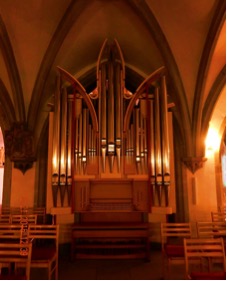
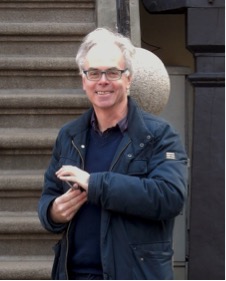
The crypt organ where I rehearsed daily. Barry Jordan
In this first article, three organs in the following cities/countries will be discussed: Budrio, Italy; London, England; and Roquemaure, France. In February, 2016, a second article will follow with a detailing of the six organs built by Antonio Xavier Machado (1807) in the Palais Nationale de Mafra, Portugal, the Hans Scherer organ (1631) in Tangermünde, and the Lorenz de Prato organ (1476) in San Petronio Basilica, Bologna, Italy.
All videos are uncut and unedited and were done with a digital Zoom Q3HD recorder. The intent of the recordings is to provide an opportunity to hear the various colors of each organ.
********
Part I
St. Agatha Church, Domenico Maria Gentili Organ (1790), Budrio, Italy
Enrico Presti, a freelance organist in Italy and throughout Europe, as well as curator of the St. Agatha Church organ in Budrio, Italy, invited me to perform a concert on April 22, 2015. Two days prior to the concert, Enrico retrieved me from my hotel in Bologna and we made our way to Budrio, a small town (pop. 8941) located about ten miles northeast of Bologna, in Emilia- Romagna, a northern portion of Italy that stretches almost all the way from coast to coast.
Budrio’s claim to fame is the 1853 invention of the terracotta ocarina, a popular medieval musical wind-instrument. The Museum of the Ocarina houses the entire evolution of the wind instrument including tools, photos, records, scores and documents.
As Enrico and I drove into this beautiful, quaint town (many of the European small towns were quaint and picturesque) steeped in history, we were treated to lovely views, architecture, and because it was springtime, my favorite flowering vines: Wisteria.
In the Medieval era, Budrio was surrounded by defensive walls and towers however, only the eastern wall and four towers remain after a 1911 demolition. Pictured above is the southeastern tower built in the 16th century and a section of the remaining eastern wall built in the 14th century,…dramatically draped in wisteria.
The St. Agatha Church houses a magnificent organ by Domenico Maria Gentili from Medicina (1790, opus 29) which was restored by Paolo Tollari in 1998 on behalf of the club, Friends of the Arts Budrio.
Specifications for the Domenico Maria Gentili organ are:
Mechanical Action.
Keyboard: 45 keys (C1-C5) with short first octave. Pedal: 18 keys (C1-G#2) with short first octave.
Principale 8’ Ottava 4’ Quintadecima Decimanona Vigesimaseconda Vigesimasesta Flauto in 12o Voce Umana
The lever on the right, when hitched down and to the right, activates the 16’ in the short pedal octave. Otherwise, the pedals play at 8’ only.
One of the deteriorated interior columns prior the restoration of St. Agatha Church.
Photo by Anna Bovoli
My view as I prepare to leap down twenty-four inches to the first step, trying not to break a leg on my way to my concert!
During my concert rehearsal, I recorded Settima Toccata (da Toccate e correnti d’intavolatura d’organo e cimbalo, Roma, c. 1634 by Michel Angelo Rossi. The meantone tuning emphasized the extreme chromaticism of the piece, especially on the last page. For a sound sample please visit this link:
https://www.facebook.com/faythe.freese/videos/vb.716346070/10153189761656071/?type=3&t heater
While I was a guest in Budrio and preparing for my concert on Wednesday, April 22, 2015, I took many walks through the town. The views through my camera viewfinder as seen below, were artistic and kaleidoscopic in nature, so much beauty was contained in small geographical area.
One of the many flower shops that the Italians hold so dear…
Below, is the concert program for Wednesday, April 22, 2015 at St. Agatha Church:
Michel Angelo Rossi
(Genova 1601 – Roma 1656)
Girolamo FRESCOBALDI
(Ferrara 1583 – Roma 1643)
Settima Toccata
(da Toccate e correnti d’intavolatura d’organo e cimbalo, Roma, c. 1634)
Da Messa della Domenica:
[Toccata avanti la Messa della Domenica] Kyrie
Christe
Kyrie
(da Fiori musicali di diverse compositioni…, Venezia 1635)
Ingrid Silvéus, soprano
Toccata Quinta (da Il secondo libro di toccate, canzone, versi d’hinni magnificat…, Roma 1627)
Da Messa della Madonna:
[Toccata avanti il Ricercar]
Recercar con obligo di cantar la quinta parte senza toccarla (“Intendomi chi può, che m’intend’io”)
(da Fiori musicali di diverse compositioni…, Venezia 1635)
Ingrid Silvéus, soprano
Preludio per organo
Voluntary in do minore
Sonata in Fa maggiore:
Presto
Andante moderato
Allegro comodo
Paduana Lachrimae (trascrizione
di Flow, my tears di John DOWLAND)
Fantasia Chromatica
Giovanni Battista PERGOLESI
(Jesi 1710 – Pozzuoli 1736)
Maurice GREENE
(Londra 1696 – ivi 1755)
Francisco Xavier BAPTISTA
(Lisbona 17?? – ivi 1797)
Jan Pieterszoon SWEELINCK
(Deventer, Olanda, 1562 – Amsterdam 1621)
The fabulous Bologna soprano, Ingrid Silvéus, sang on Frescobaldi’s Messa della Domenica and Messa della Madonna. Ideally, the “Recercar con obligo” is to be sung by the organist however, this organist is no vocal soloist. Our encore was Bist du bei mir by the venerable Johann Sebastian Bach.
For the concert, St. Agatha Church was filled to capacity with an enthusiastic audience. To say that the Italians love the pipe organ would be an understatement. In particular, this audience was extremely proud of this beautifully restored building and instrument.
Post-concert photo of Ingrid Silvéus and Faythe Freese.
As Enrico and I left on Thursday, April 23 for the Bologna train station, he presented the lovely ocarina pictured below to me. I considered incorporating the ocarina into one of my organ concerts when I had finally mastered playing it. Mastery has yet to happen!
St. Barnabas Church, Gerard Smith (1851), Gray & Davison (1871), Hill & Son (1877), Nicholson & Co (2011), Ealing, England, Ealing Broadway Station
In late February, the German immigration services required my departure from the Schengen area for visa reasons. I pondered how to turn this unforeseen excursion from lemons into lemonade since all of the countries in my sabbatical proposal were Schengen countries. I recalled that in 2009, I led a group of 25 organists to England, a non-Schengen country, on a study tour, with the help of Keith Cole from Witte Travel. The first person with whom we connected upon our arrival in the United Kingdom was Paul Joslin, a walking, talking encyclopedia of all things pertaining to organs in the UK. Paul was to be our guide for a tour of twenty-three organs throughout the greater London area and more importantly, he was an exceptional conversationalist. Soon, he and I became good friends, remaining in touch throughout the years thereafter. I decided that traveling to the UK not only provided the required time outside of the Schengen area, but also provided an “excuse” to visit Paul and his lovely wife, Gwen. Perhaps we could even create an impromptu organ crawl through London!
Thanks to Thomas Cromwell, there is not a profusion of historic instruments in England, such as those found in other European countries. There are, however organs of importance with interesting tonal and mechanical designs. Upon contacting Paul, he became as excited as I, with the possibility of a London organ crawl, so on March 10th, I made my way from Magdeburg, Germany to London and my temporary home at the Tune Hotel at Canary Wharf.
Tune Hotels offer an interesting array of ala carte options, each option with an attached price tag. A room can be had with or without a window, with or without towels, with or without Internet, with or without shampoo…well, you get the drift. I opted for the underground cave (no window) and paid 12 pounds extra for the Internet. Next door to the Tune Hotel, was Docklands Diner, previously a 1800s prison for French Prisoners of the Napoleonic Wars, a favorite breakfast spot of London’s finest. Posted on the wall was the following:
Docklands Diner had a most interesting and practical way of keeping the flies out of the sugar bowl, as the saucer lid provides a handy resting place for the sugar spoon.
On March 11, Paul and I met up and proceeded for three days to visit some great and exceedingly diverse organs. To name a few, there was a lovely Richard Bridge organ (1735) at
Christ Church Spitalfields; the J.W. Walker organ (1891) at Holy Trinity, Sloane Square and the wonderful Henry Willis organ (1877) at Union Chapel, Islington.
The last church we visited on March 13, 2015 was St. Barnabas Church in Ealing, the home of the Hill & Son organ (1877). St. Barnabas Church, built just before WWI in 1914-1916, ran out of funds and therefore, the West-end towers, the North Chapel, and the 3-manual, 45-stop Henry Willis organ were never built. A “temporary” organ of two manuals and twenty-three stops, a composite of two older organs, included a short compass swell. The organ was never capable of leading hymn singing in a building of this size. A 1966 rebuild by Noterman however, which included a new detached console, enabled the organ to limp along, becoming increasingly unreliable until its demise in 2010.
In 2005 a large, three-manual instrument became available at St. Jude’s Church, Southsea. The organ was built by Gerard (George) Smith originally as a two-manual organ and was first heard in concert on October 25, 1851 by the Winchester Cathedral Choir with Dr. S.S. Wesley at the console. In 1869, the organ was increased to three-manuals. The organ suffered fire damage in 1870, and Gray and Davison completed a rebuild in 1871. It soon became apparent that the rebuild was a failure. Consequently, Hill & Son rebuilt the organ again in 1877. The action was improved throughout the years: tracker to Barker Lever (1877) to exhaust tubular-pneumatic (1901/1912).
In 2009 the organ was moved from St. Jude’s Church and rebuilt and installed in St. Barnabas (2011) by Nicholson & Co. of Malvern. The stop specification and pipes have remained the same since 1877. The following changes were made:
1. The action was changed to electro-pneumatic;
2. The pitch was lowered to A=440 to enable the organ to be used with orchestras;
3. A “Great Reeds on Choir” coupler and modern playing aides were added, yet the 1912
Hill console was mostly retained; and 4. The left case (Swell) is entirely new.
The consultant for the project was Paul Joslin.
A view of the nave and chancel from the organ.
Specifications 2011
Pedal Key action TP Stop action TP Compass-low C Compass-high f1 Keys 30
- 1 Open Diapason
- 2 Violone
- 3 Bourdon
- 4 Quint
- 5 Principal
- 6 Bass Flute
- 7 Trombone
16 1851 16 1877 16 1851 12 1877 8 1851 8 1877 16 1851
Choir Key action TP Stop action TP Compass-low C Compass-high g3 Keys 56
- 8 Lieblich Bourdon 16 1877
- 9 Lieblich Gedackt 8 1872
- 10 Dulciana
- 11 Gamba
- 12 Gemshorn
- 13 Suabe Flute
- 14 Flageolet
- 15 Clarinet
8 1872 8 1851 4 1872 4 1872 2 1851 8 1877
Great Key action TP Stop action TP Compass-low C Compass-high g3 Keys 56
- 16 Double Diapason
- 17 Open Diapason No.1
- 18 Open Diapason No.2
- 19 Stopped Diapason
- 20 Claribel
- 21 Gamba
- 22 Principal
- 23 Harmonic Flute
- 24 Twelfth
- 25 Fifteenth
- 26 Mixture
- 27 Mixture
- 28 Posaune
- 29 Trumpet
- 30 Clarion
16
8
8
8
8
8
4
4
2 2/3 2
III II 8 8 4
1851
1877
1851
1851
1877
1872
1851
1851
1872
1851
1851, 15.19.22 1877, 26.29 1877
1851 1851
Swell Key action TP Stop action TP Compass-low C Compass-high g3 Keys 56 Enclosed
- 31 Bourdon
- 32 Open Diapason
- 33 Stopped Diapason
- 34 Keraulophon
- 35 Salcional
- 36 Vox Angelica
- 37 Principal
- 38 Fifteenth
- 39 Piccolo
- 40 Mixture
- 41 Double Trumpet
- 42 Cornopean
- 43 Oboe
- 44 Vox Humana
- 45 Clarion
16 1851
8 1851
8 1851
8 1851
8 1877, sic 8 1877
4 1851
2 1851
2 1877
III 1851, 15.19.22 16 1877
8 1851 8 1851 8 1877 4 1851
46 Tremulant
Console
Stop type: drawstop
Couplers
Swell to Pedal
Swell to Great
Swell to Choir
Swell octave
Swell suboctave
Choir to Pedal
Great to Pedal
Details
Blowing Electric (Watkins & Watson) Accessories
Balanced Swell pedal
4 thumb pistons each to Great and Swell 3 thumb pistons to Choir
4 composition pedals to Pedal
Great pistons to Pedal pistons
Gt-Pd toe pedal
Great Reeds on Choir
Label type: ivory
Pedalboard: concave radiating sharps; angled jambs
The new layout of the Swell division. The façade pictured above is an exact copy of the Choir division on the right-hand side.
The chancel walls are adorned with painted canvases.
To provide a sample of the lovely tonal palette of this instrument, here is an impromptu recording of To Call My True Love to My Dance by Naji Hakim. This piece which I commissioned from Dr. Hakim, truly shows off the colors of this great instrument.
insertZoom0009=
Var. 1 7:08-8:19 Var. 2 9:30-8:19 Var. 3 10:53-11:45 Var. 4 12:31-13:20 Var. 5 14:41-15:34 Var. 6 16:44-17:44 Var. 7 18:53-19:52 Var. 8 20:00-20:58 Var. 9 21:14-23:19 Finale 24:02-30:02
Of course, what travelogue would be complete without a photo of Big Ben?!
Church of Saint Jean-Baptiste and Saint Jean l’Evangéliste, Jullien Frères Organ (1690) Roquemaure, France (Provence)
Although I returned from my spring sabbatical to the University of Alabama on May 3, my sabbatical was extended as I traveled across the pond once more in June as the guest organist for the Church of the Nativity, Huntsville, Alabama choir under the direction of Dr. Suzanne Purtee for their Evensongs in England and Scotland. Once we arrived, I was hopping on historical instruments either to prepare for the Evensongs or as brief side journeys when not otherwise engaged in worship service, but there will be more on those instruments in a subsequent article. Following the England choir tour, my husband, Jerry, and I rendezvoused in Paris on July 4. We took the TGV train to Avignon and vacationed in Provence, France for a 4-day wine-tasting tour and a 4-day bike tour. On the first day, as a surprise, Jerry arranged for a visit to Roquemaure, a village located 15 km from Avignon, located on the right bank of the Rhône river. The Collegiate Church of Saint Jean-Baptiste and Saint Jean l’Evangéliste, located in Roquemaure, was built in 1329 under the direction of Bertrand cardinal of Pujet, the nephew of the pope Jean XXII and is the home of the Jullien Frères organ built in 1690. Voilà! Jerry’s surprise.
On the way to Roquemaure, our driver, guide and wine connoisseur, François Marcou, President of Avignon Wine Tours, squired us through sunflower country. François, had the amusing habit of announcing that he had a surprise for us, and this pronouncement was always accompanied by classical music on the car stereo. Just as we would arrive at the “surprise”, which was usually some historical monument or jaw-dropping, scenic overlook…or a field of sunflowers, the music would climax with a major work such as Richard Strauss’ Also sprach Zarathustra. Trés jolie!
François! Always laughing, telling stories.
Doesn’t everyone stop in a sunflower field on the way to Sunday mass? At this point, I did not know that my beloved, Jerry, had arranged to visit the Jullien organ and attend mass.
When we arrived at the church, a mere thirty minutes before the mass, Robert Rivollier, the organist for Saint Jean-Baptiste welcomed us. After briefly explaining the 1690 Jullien organ, Mr. Rivollier invited me to play a prelude for the mass to which I agreed. A few minutes later, he requested that I play a postlude also to which I agreed. Finally, he requested that I play for communion, and of course I accepted the invitation. What fun!
The organ was built by the Jullien brothers of Marseilles for the church of Cordeliers of Avignon. The organ fell into obscurity for several centuries however in 1965 it was rediscovered and became the replacement for the 1642 organ of Frères Eustaches, which was burned during the French revolution. The Jullien organ is of rare quality and today is the object of famous studies of organists and schools of organ builders. It probably contains the most significant ensemble of original pipes of the 17th century and is classified as an historic monument. The organ case with its two towers dates from the 18th century contains the thousand pipes of this instrument.
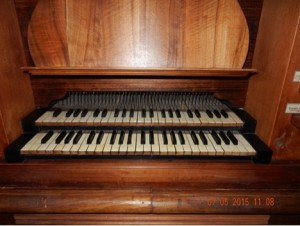
Pedalboard? Yipes!
The organ composition is based on the Spanish style, having separate windchests for bass and treble with split manuals and a small pedal compass with only eight keys. The tierce is narrow in scale which is rarely found in 18th C. French organs. The pipes are rolled metal of Italian style and there are powerful and characteristic reed stops which enable compelling performances of French, Spanish and some Italian baroque music.
Rickety stairs up to the second level of the pipe chambers.
Specification Organ temperament:
French baroque temperament at a1=415 Hz Tuning table (Cents)
Manual and pedal compasses:
Grand orgue: C, D, D# – c3 (divided in bass (basses) and treble (dessus) at d#1) Récit: c1 – c3
Pedal stubs: c, d, e, F, G, A, A# , B
|
c 0 |
c# 88 |
d 197 |
dis 302 |
e 398 |
f 497 |
fis 590 |
g 700 |
g# 788 |
a 898 |
a# 1000 |
h 1095 |
Stop list:
Grand Orgue (C,D–c3)
01. Montre 8
02. Bourdon 8
03. Prestant 4
04. Flûte 4 (basses et dessus)
05. Nazard 2 2/3 (basses et dessus) 06. Doublette 2 (basses et dessus) 07. Tierce 1 3/5 (basses et dessus) 08. Larigot 1 1/3 (basses et dessus) 09. Fourniture 3 rangs
10. Cymbale 3 rangs
11.Trompette 8 (basses et dessus)
12. Cromorne 8′ (basses et dessus)
13. Voix humaine 8′ (basses et dessus) 14. Cornet 5 rangs (dessus)
Récit (c1–c3)
01. Bourdon 8 et Flûte 4 (permanents) 02. Cornet 3rangs
Pedal
(c, d, e, F, G, A, A#, B)
01. Basse (permanente) 02. Bombarde 16
Couplers
Pedal fixed coupled to Grand Orgue
Registration Aids
Tremblant doux Rossignol (Nightingale)
Homily is over! Wake up, I need air!
Rossignol pipes and water reservoir.
Gail, please insert sound samples from the mass:
Suite du Deuxieme Ton by Louis-Nicolas Clérambault Plein Jeu Zoom0009= :00-2:03
Flûtes Zoom0004=:00-1:16
Caprice sur les Grand Jeux Zoom0005=:06-2:29
Messe pour les Paroisses François Couperin Zoom0006=:00-:55
“Dialogue sur les Trompettes, Clairon et Tierces du Grand Clavier et le Bourdon avec le Larigot du Positif” – 4ème Couplet (Excerpt)
Lunch is served. Bon appétit!
A field of lavender in the early evening at the Château Gigognan. ROQUEMAURE BIBLIOGRAPHY
Maier, H. (2002) 1690 Fréres Jullien Organ. Available at: http://www.organartmedia.com/jullien (Accessed: 15 October 2015).

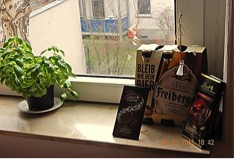
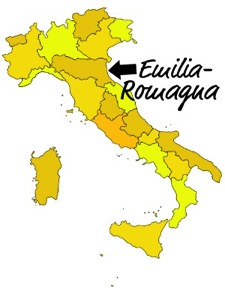
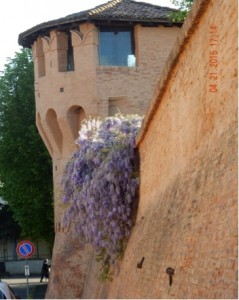
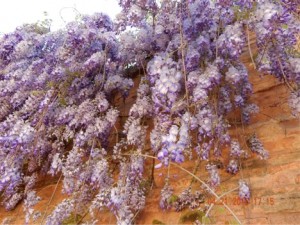
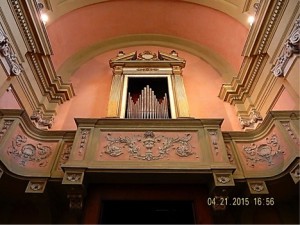
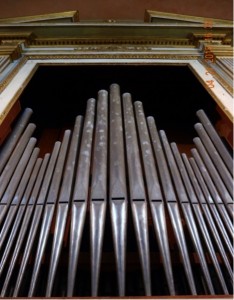
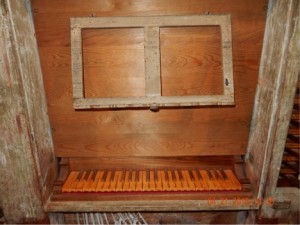
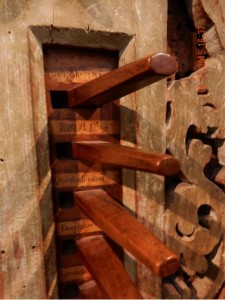
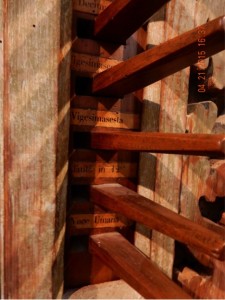
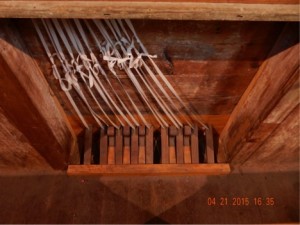

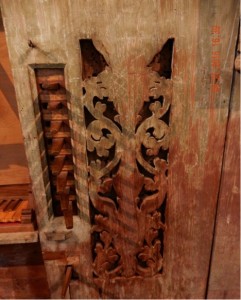
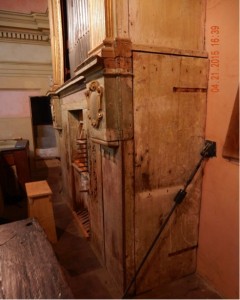
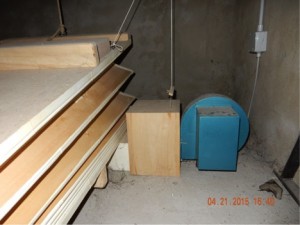
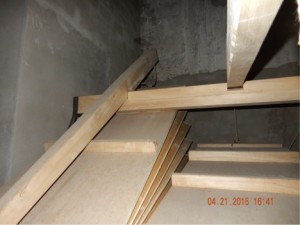
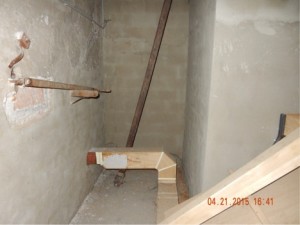
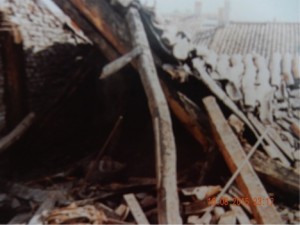
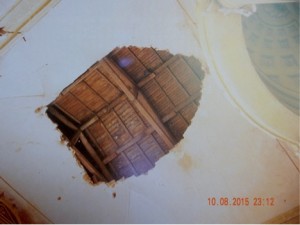

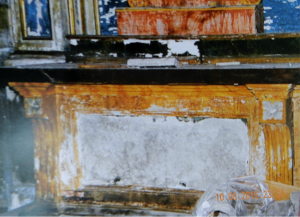
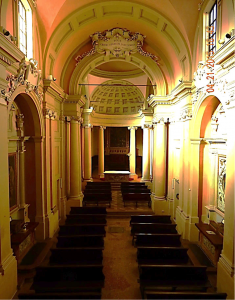
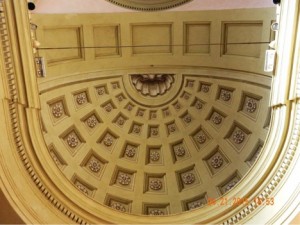
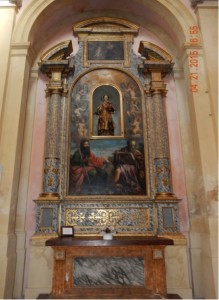
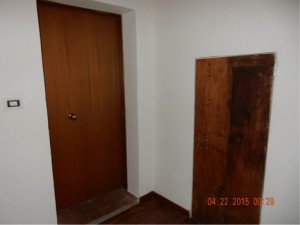
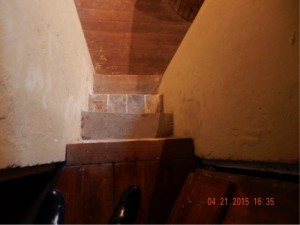
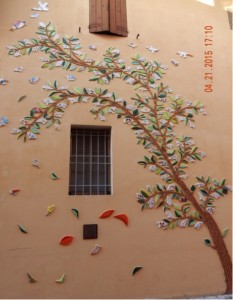
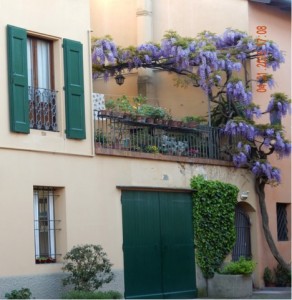
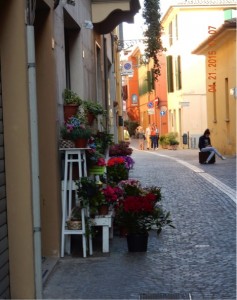
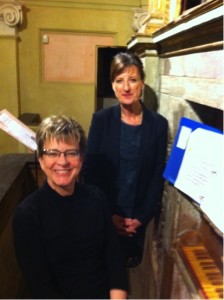
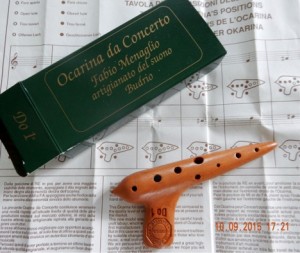
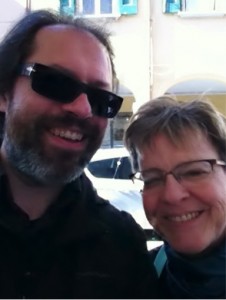
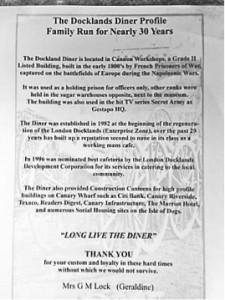
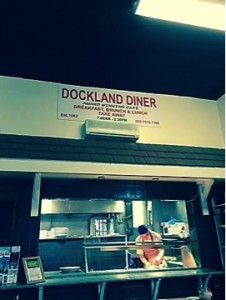
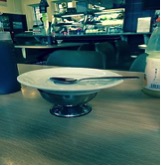
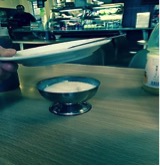
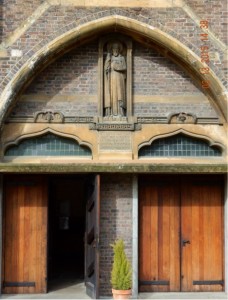
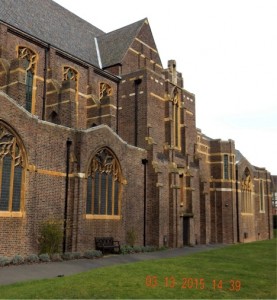
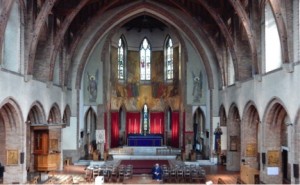
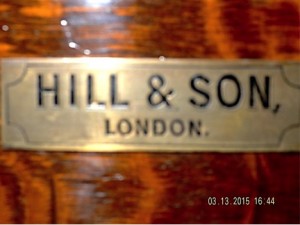
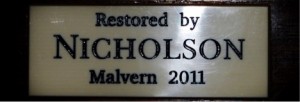
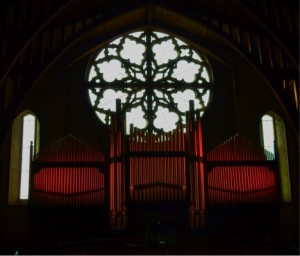
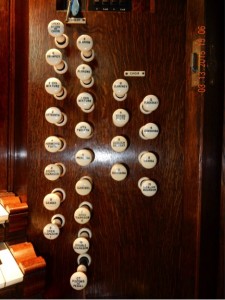
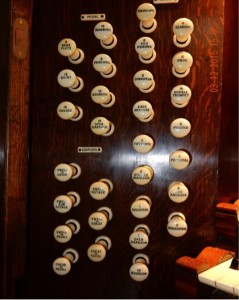
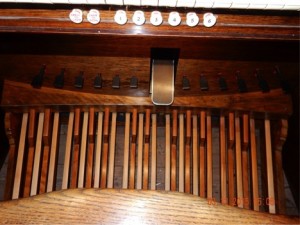
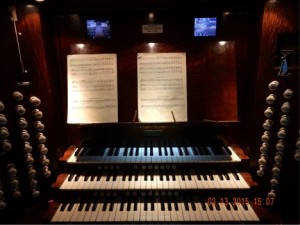

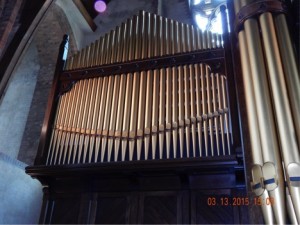
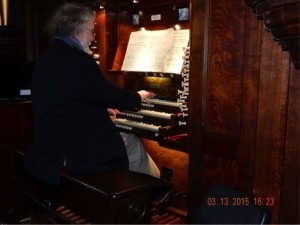
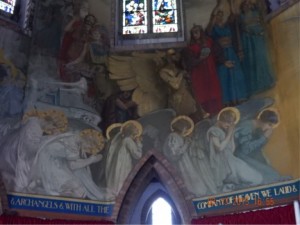
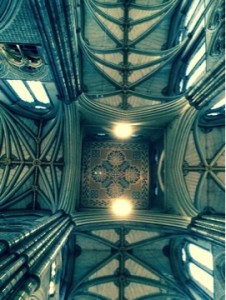
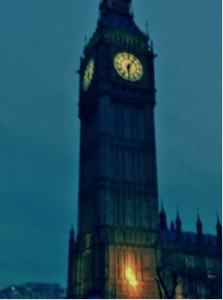
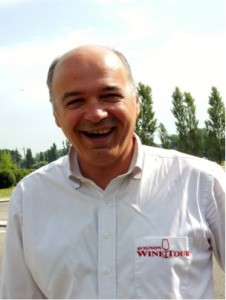
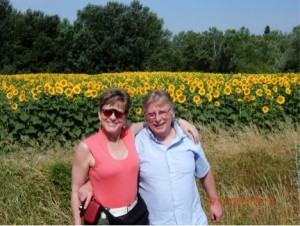
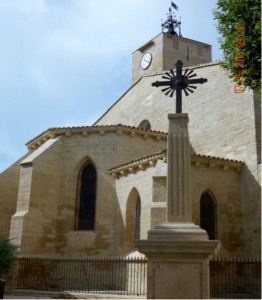
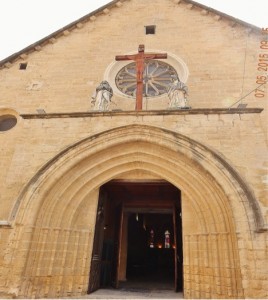
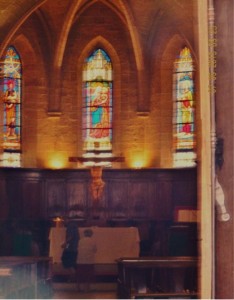
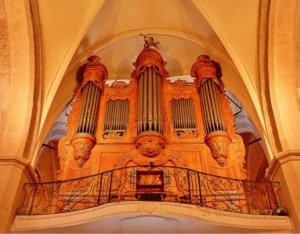
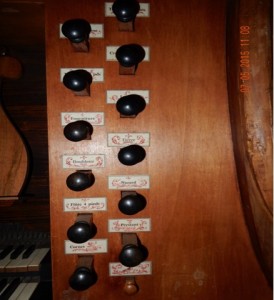
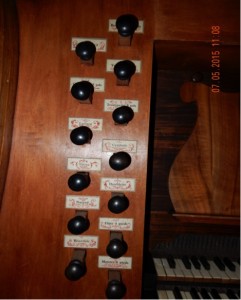
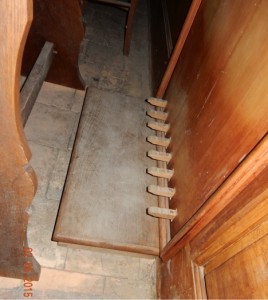
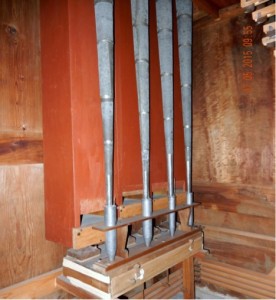
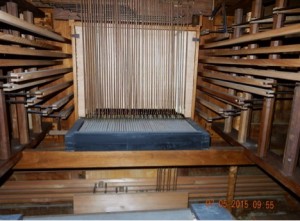
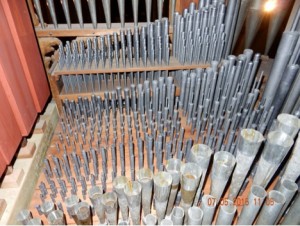
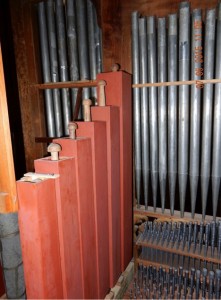
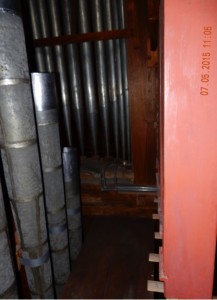
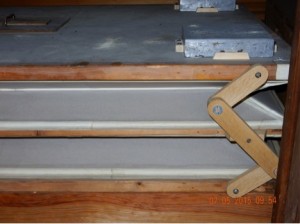
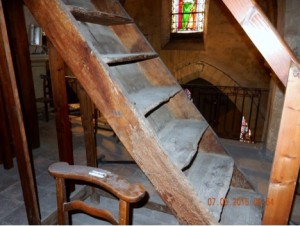
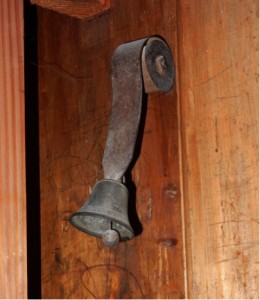
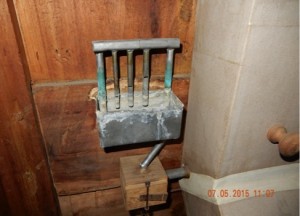

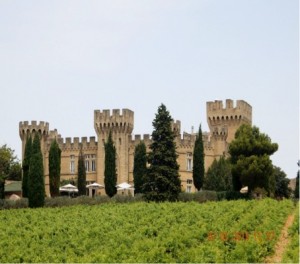
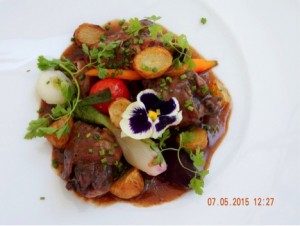
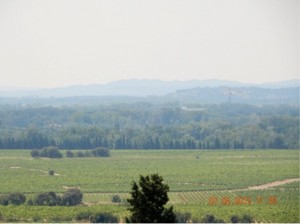
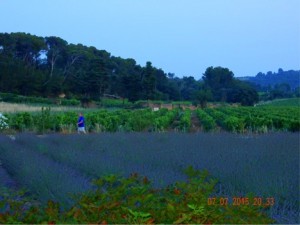
Recent Comments